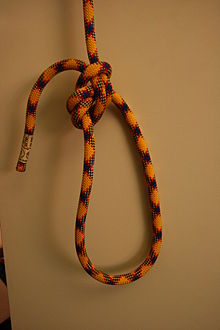Bulin 1.5
| Bulin 1.5 | |
|---|---|

|
|
| Type | loop |
| application | Rope knot |
| Ashley No. | |
| strength | approx. 67% |
| English | Yosemite bowline, Bowline with Yosemite finish |
| List of nodes | |
The Bulin 1.5 serves as a secure rope knot that is very easy to detach after loading. When knotting, however, a non-resilient, continuous knot can arise through internal displacement .
Names and history
The Bulin 1.5 is a modification of the Bulin . It was first described as a rope knot by John Harlin in the late 1970s . It was developed after it was discovered that the common bulin loosens under ring loading and is therefore unsuitable as a rope knot. The name Bulin 1.5 comes from Christian Semmel (former head of security research at DAV ). It is also known as the bowline with Yosemite back-up or Bulin with Yosemite back-up.
hazards
When knotting, the last loop made slipping up the inside of the loop unnoticed can result in a dangerous noise knot (a figure eight knot through which the end of the rope is simply threaded and therefore slips freely). Both knots are difficult to tell apart.
However, not every incorrectly tied Bulin 1.5 knot apparently poses a safety risk.
application
The Bulin 1.5 forms a particularly secure, firm loop .
The decisive factor is its high knot strength : the rope retains around 67 percent of its original tear strength . Of all loop knots used in climbing, it has the highest breaking strength and weakens the rope the least. In this respect, the Bulin 1.5 is superior to the figure-of-eight knot (63 percent) used worldwide in climbing and rescue . The Bulin 1.5 serves as an alternative rope knot. It has the advantage over the figure-of-eight knot that it can be easily loosened again after high or multiple loads as well as in a damp or frozen state. If necessary, it can be knotted with one hand.
The knot is more prone to errors than the figure eight knot, since the correct knot is difficult to understand visually.
When climbing along and for rescue operations of eight knot is recommended by all organizations and preferred.
Knot
The Bulin 1.5 is plugged into the climbing harness (see above ): You loop an eye into the end of a rope so that about one meter of rope end remains free and guide it through the loops of the climbing harness.
Now you run the loose end through the eye, around the fixed (long) end, and back through the eye (as with the internal bulin ). It is crucial that you lead the loose end into the eye from the right side and vice versa back through the eye so that the two rope ends are parallel. If one dips into the eye from the wrong side, there will be no knot.
In contrast to the Bulin, you now move the loose end parallel to the little eye so that the loose end comes to lie parallel to the long end, creating a kind of "half figure eight knot". Then carefully tighten the knot. Make sure that you tighten the bowline first and then the return. Tightening the return first can partially loosen the knot, creating an unsafe knot.
Alternatives
- The figure eight is the official rope knot for climbing competitions .
- The double bulin is also easy to loosen after use and less prone to errors.
- If a tight loop is required in the middle of a rope, the butterfly knot is recommended .
- If a simple loop is required for safety-relevant applications, a bowline is sufficient .
swell
- ↑ Yosemite Bowline not safe for climbing. Retrieved February 9, 2016 (a video demonstrating the unsecured slipped Bulin 1.5 knot).
- ^ A b Mark Gommers: An Analysis of Bowlines . 2.3a edition. February 2, 2016, p. 31 ( PDF ).
- ↑ James Titt: Load testing of mis-dressed Yosemite bowline knot . July 16, 2012.
- ↑ The 5 Biggest Safety-Related Myths in Rock Climbing .






